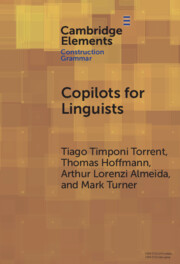Refine search
Actions for selected content:
19 results
Large language model driven development of turbulence models
-
- Journal:
- Flow: Applications of Fluid Mechanics / Volume 5 / 2025
- Published online by Cambridge University Press:
- 21 November 2025, E40
-
- Article
-
- You have access
- Open access
- HTML
- Export citation
Beyond human gold standards: A multimodel framework for automated abstract classification and information extraction
-
- Journal:
- Research Synthesis Methods ,
- Published online by Cambridge University Press:
- 17 November 2025, pp. 1-13
-
- Article
-
- You have access
- Open access
- HTML
- Export citation
Enhancing designer creativity through human–AI co-ideation: a co-creation framework for design ideation with custom GPT
-
- Article
-
- You have access
- Open access
- HTML
- Export citation
Relative importance of lexical features in word processing during L2 English reading
-
- Journal:
- Studies in Second Language Acquisition , First View
- Published online by Cambridge University Press:
- 29 August 2025, pp. 1-24
-
- Article
-
- You have access
- Open access
- HTML
- Export citation
Decoding the grammar of design theory for large language models: the case of axiomatic design theory
-
- Journal:
- Proceedings of the Design Society / Volume 5 / August 2025
- Published online by Cambridge University Press:
- 27 August 2025, pp. 1121-1130
-
- Article
-
- You have access
- Open access
- HTML
- Export citation
Can large language models support machine learning implementation in product development? A comparative analysis and perspectives
-
- Journal:
- Proceedings of the Design Society / Volume 5 / August 2025
- Published online by Cambridge University Press:
- 27 August 2025, pp. 861-870
-
- Article
-
- You have access
- Open access
- HTML
- Export citation
Creating design catalog from patent documents with large language model for design concept generation
-
- Journal:
- Proceedings of the Design Society / Volume 5 / August 2025
- Published online by Cambridge University Press:
- 27 August 2025, pp. 1051-1060
-
- Article
-
- You have access
- Open access
- HTML
- Export citation
6 - LLMs Meet the AI Act
- from Part II - Evolving Regulatory and Governance Frameworks
-
-
- Book:
- The Cambridge Handbook of Generative AI and the Law
- Published online:
- 08 August 2025
- Print publication:
- 07 August 2025, pp 85-98
-
- Chapter
- Export citation
Enhancing TRIZ through environment-based design methodology supported by a large language model
-
- Article
-
- You have access
- Open access
- HTML
- Export citation
A novel idea generation tool using a structured conversational AI (CAI) system
-
- Article
-
- You have access
- Open access
- HTML
- Export citation
Promises and pitfalls of large language models in psychiatric diagnosis and knowledge tasks
-
- Journal:
- The British Journal of Psychiatry / Volume 226 / Issue 4 / April 2025
- Published online by Cambridge University Press:
- 29 April 2025, pp. 243-244
- Print publication:
- April 2025
-
- Article
-
- You have access
- HTML
- Export citation
A large language model based data generation framework to improve mild cognitive impairment detection sensitivity
-
- Journal:
- Data & Policy / Volume 7 / 2025
- Published online by Cambridge University Press:
- 26 March 2025, e33
-
- Article
-
- You have access
- Open access
- HTML
- Export citation
Generalizable and scalable multistage biomedical concept normalization leveraging large language models
-
- Journal:
- Research Synthesis Methods / Volume 16 / Issue 3 / May 2025
- Published online by Cambridge University Press:
- 12 March 2025, pp. 479-490
-
- Article
-
- You have access
- Open access
- HTML
- Export citation
ChatGPT as an inventor: eliciting the strengths and weaknesses of current large language models against humans in engineering design
-
- Article
-
- You have access
- Open access
- HTML
- Export citation
A Reliable Common-Sense Reasoning Socialbot Built Using LLMs and Goal-Directed ASP
-
- Journal:
- Theory and Practice of Logic Programming / Volume 24 / Issue 4 / July 2024
- Published online by Cambridge University Press:
- 15 January 2025, pp. 606-627
-
- Article
-
- You have access
- Open access
- HTML
- Export citation
Evaluating large-language-model chatbots to engage communities in large-scale design projects
-
- Article
-
- You have access
- Open access
- HTML
- Export citation

Copilots for Linguists
- AI, Constructions, and Frames
-
- Published online:
- 20 December 2023
- Print publication:
- 01 February 2024
-
- Element
- Export citation
Large Language Model (LLM)-Powered Chatbots Fail to Generate Guideline-Consistent Content on Resuscitation and May Provide Potentially Harmful Advice
-
- Journal:
- Prehospital and Disaster Medicine / Volume 38 / Issue 6 / December 2023
- Published online by Cambridge University Press:
- 06 November 2023, pp. 757-763
- Print publication:
- December 2023
-
- Article
- Export citation
Generative Pre-Trained Transformers (GPT) and Space Health: A Potential Frontier in Astronaut Health During Exploration Missions
-
- Journal:
- Prehospital and Disaster Medicine / Volume 38 / Issue 4 / August 2023
- Published online by Cambridge University Press:
- 02 June 2023, pp. 532-536
- Print publication:
- August 2023
-
- Article
-
- You have access
- Open access
- HTML
- Export citation


